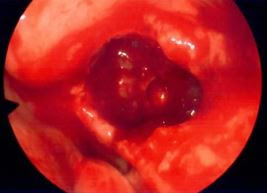Don't ignore a tooth problem, get to your dentist ASAP, since a bad tooth/teeth can lead to bad things. Yes, even just one of those little critters in your mouth can lead to a world of hurt. Infections of a tooth or several teeth can spread to adjacent areas, such as the face, mouth and throat, down into the neck (see Deep Neck Infections and Abscesses), and the paranasal sinuses. The sinuses? You bet. The photo above was taken from a patient who had a tooth infection that trekked up into her maxillary sinus. The infection travelled from the tooth, along its roots, and through the floor of the sinus above.
Due to the proximity of the upper teeth to the sinuses, patients with sinusitis (inflammation of the sinuses) often can have upper teeth discomfort along with their facial discomfort. However, sinus infections affect or are affected by the upper teeth only. I’m surprised by a number of patients who present with “sinus infections” stating they feel it in their lower teeth. It doesn’t work that way for the simple anatomic reason that sinuses are air spaces above the upper teeth. There are no sinuses (air spaces) below the lower teeth in the mandible or lower jaw. You wouldn’t want air spaces in the jaw anyway, when all that chewing and loud chatter could conceivably break an air-filled jaw.
The picture above shows a CT (computed tomography scan) through
the face, showing the left maxillary sinus opacified from a tooth
infection. The photo to the right of the
CT shows a probe pushed into the blocked ostium (natural opening into
the sinus) to release some of the pus.
The photo below peers into the opened sinus to reveal the inflamed and
infected tissue.
It’s unusual for sinusitis to cause problems with the teeth. It’s usually the other way around, where a bad tooth causes the sinusitis. The roots of the upper teeth can come close to the floor of the maxillary sinus; it is not unusual for these roots to actually project into the sinus. An infected tooth can spread along the root and enter the sinus. An infection tracking along the tooth can inflame the lining tissue (mucosa) of the sinus cavity, forming pus that fills up the sinus. Pus naturally drains from the natural opening (ostium), but sometimes the infection narrows or blocks that opening, making it difficult to clear the infection. The inflammation can also spread from the maxillary sinus to the adjacent ethmoid and frontal sinuses.
The infected tooth or teeth must be addressed first. It’s paramount to treat the source of the infection with antibiotics, sometimes steroids, a root canal to remove the infectious tract or removing the offending tooth/teeth. Often this will alleviate the dental infection and the associated sinusitis. If despite these measures the poor patient still has a sinus infection, then sinus surgery is needed.
Endoscopic sinus surgery has been discussed before (see Sinus Surgery). The purpose of surgery is to restore the natural outflow of the sinus by removing inflamed tissue blocking that outflow, along with removing “diseased tissue” (inflamed, infected mucosa) from the affected sinus. I’ve had a few cases where part of a tooth root was inadvertently left behind after a tooth extraction which found its way up into the sinus. After initially removing some of the infected tissue, I unexpectedly found the root stuck in the maxillary ostium! The sinus was trying to push the culprit out.
Why is that? The sinuses are lined with mucosal cells that have cilia—microscopic hair-like projections from the cell. Cilia bend and move, naturally propelling secretions and mucous towards the sinus ostium and out of the sinus. In cases with a retained tooth root, the cilia of maxillary sinus was trying to move the piece of tooth out of the sinus, only the tooth remnant was too large to pass through the natural ostium, which is normally only 1-2mm in diameter. Surgery required removing first the infected tissue to gain entrance into the sinus (removing much of the infected maxillary fontanelle as shown in the picture above), creating a very large opening into the sinus, and removing the inflamed tissue lining the sinus space. Fortunately, this is quite rare. I only wish I took photos of those cases!
On the flip side, if there is blockage of the ostium, the trapped mucous can turn into pus, and can affect the teeth. This is a situation where the sinus infection occurs first, leading to discomfort and pain over the teeth. Sinus surgery will help if medical treatment fails. If the ostium is unaffected and the bottom part of the maxillary sinus is infected, this is typically a problem of the tooth/teeth, and sinus surgery would not help.
The lesson: if your tooth gives you a problem, or you notice something not quite right (for instance, a crack or obvious cavity in the tooth) see your dentist immediately! Don’t wait for something awful to happen.
©Randall S. Fong, M.D.
For more topics on medicine, health and the weirdness
of life in general, check out the rest of the blog site at randallfong.blogspot.com


Comments
Post a Comment